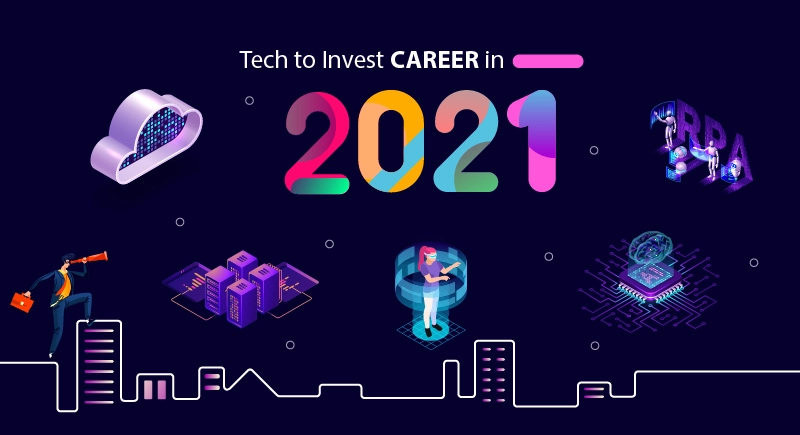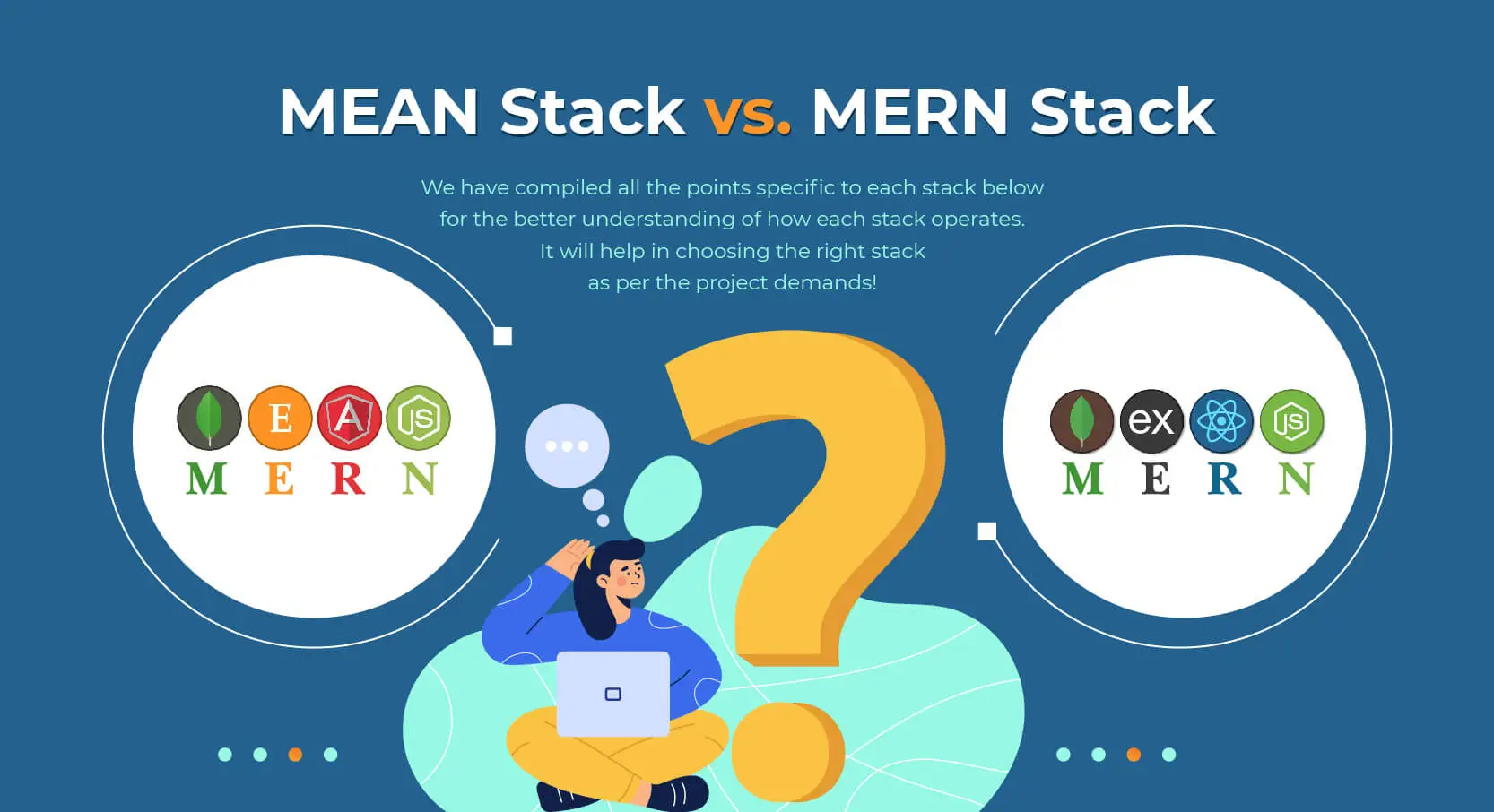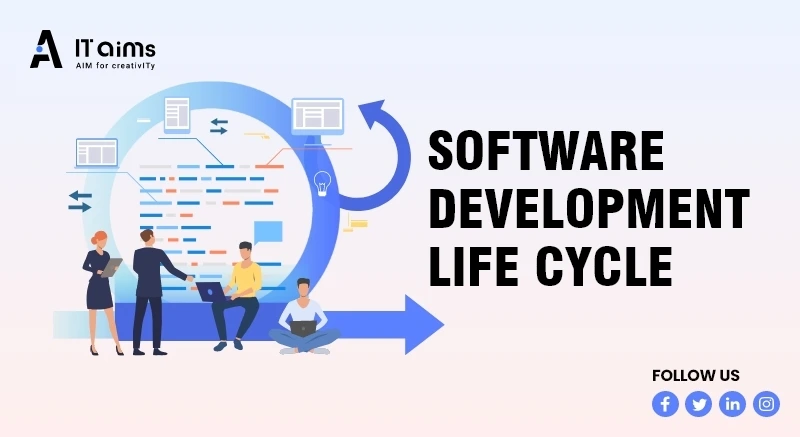
Software Development Life Cycle (SDLC) : Meaning, Models, Cycle and Phases
SDLC Meaning
The SDLC or Software Development Life Cycle consists of a series of stages that help organisations develop, test, and maintain medium to large-scale software. By following the SDLC, one can create software that exceeds expectations and deliver the project on time and within budget. SDLC defines steps or tasks to be followed at each phase in software development. As per iso.org, the definition of SDLC is as follows.
"ISO/IEC 12207:2008 establishes a common framework for software life cycle processes, with well-defined terminology, that can be referenced by the software industry."
SDLC is useful for every software project manager to keep track of the project. SDLC life cycle consists of several phases, and each phase has its process and expected output that goes as an input to the next phase.
Why Do We Need Sdlc ?
Let us have a look at the reasons why SDLC is required.
- It is a standard methodology that will help in project planning, scheduling and estimating.
- It provides a framework for performing a standard set of actions and their output.
- It is helpful in project tracking and control-related activities.
- With the help of SDLC, project planning is conveyed to all involved parties like developers, testers and others.
- It can improve client relations by providing them with accurate project tracking data.
SDLC Cycle
Sdlc Cycle represents the process of software development.
Below is an infographic representation of the SDLC cycle.
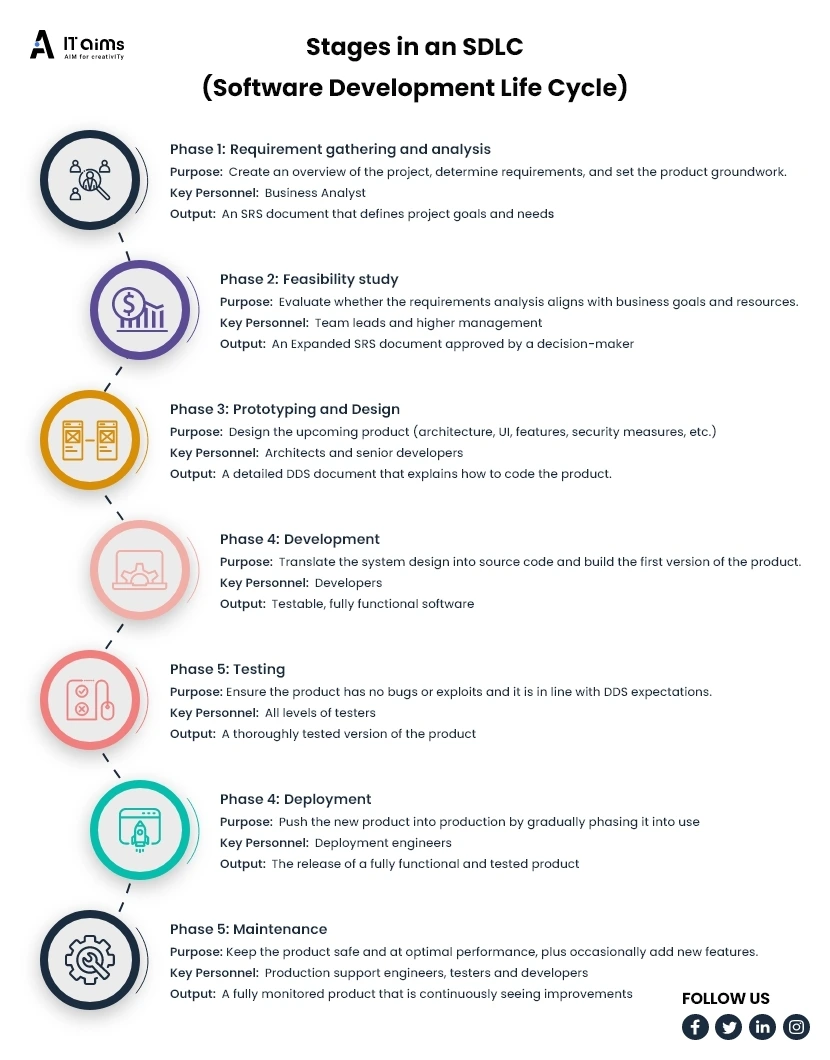
Phases of SDLC
Let us have a look at the phases of SDLC.
- Requirement gathering and analysis
- Feasibility study
- Prototyping and Design
- Development
- Testing
- Deployment
- Maintenance
Phase 1: Requirement gathering and analysis
Requirement gathering and analysis is the first step in the SDLC process. After gathering input from all the stakeholders and experts, the management team initiates this process.
There are 6 steps involved in this Process
- Assigning Key Stakeholders (Project Manager, Product Owner, BA, etc)
- Project Information Gathering and Documentation (SRS, BRD, FRD, DFD, etc)
- Listing Assumptions and Requirements
- Project Scheduling
- Assigning Developers
- Project Risk Management and Quality Assurance
- Getting approval
- Setup the Project plan on tools like Jira, Asana, Trello, etc
Risk measurement and quality assurance-related matters are also assessed at this stage. The project scope, opportunities and other directives will be looked at with utmost care in this step.
In this step, a project timeline is assessed, which is one of the most important things about the project.
Phase 2: Feasibility study
The feasibility study is the next step in the software development life cycle. It will include activities that define and document the needs of the software, including its features, functions, and specifications. This document is known as a '' Software or System Requirement Specification" document. This document includes all the things that will be developed as a part of the project.
Mainly there exist five types of feasibility to check for. Let us discuss them all.
- Economic: Budget availability and spending on the project are calculated here.
- Legal: The feasibility of the project development process is looked at from the perception of cyber law and other regulatory frameworks.
- Operation feasibility: Software is designed and developed with all the functionalities expected by the clients and is looked at here.
- Technical: A comparison and evaluation of hardware, software and other technical requirements of a proposed system with the current System configuration to check if it is sufficient to run the software.. It also focuses on the availability of the technical resources and their capability of converting the idea into working system
- Schedule: Project delivery estimate is created to determine how much time a project will take by determining how many hours per week each team member will work on the project..
Phase 3: Prototyping and Design
Design and prototyping phase is the most crucial one of all software development phases. The design phase has a list of requirements that are used to make design choices. Once the design is confirmed, the working model of software with some limited functionality is created. The prototype does not always hold the exact logic used in the actual software application and is an extra effort to be considered under time estimation.
Stepwise approach to design a Prototype
- Basic Requirement Identification - understanding the very basics product requirements especially in terms of user interface.
- Developing the initial Prototype - very basic requirements are showcased and user interfaces are provided
- Review of the Prototype - presented to the customer and the other important stakeholders in the project to collect feedback in an organized manner for further enhancements in the product.
- Revise and Enhance the Prototype - The feedback are discussed during this stage and some negotiations happen like – time and budget constraints and technical feasibility of the actual implementation.
Types of Prototype
- Rapid Prototyping
- Evolutionary Prototyping
- Incremental Prototyping
- Extreme Prototyping
These documents are going to be input for the next step of SDLC.
Phase 4: Development
Once the prototyping and design phase is over, coding for the software starts. In this phase, developers will start writing code using a selected programming language and framework. Tasks mentioned in the SRS document are converted into units or modules and distributed among developers. This phase takes the longest time among all phases in SDLC. Developers will adhere to certain coding guidelines and can use different tools to help them in the coding process, like an interpreter, IDE, Compiler and many more.
Phase 5: Testing
After the coding part, once the system is ready, it is deployed in the testing environment to test the functionality, and the dedicated testing team carries it out. Testing is done to ensure the system works per the client's requirements. If the testing team finds any bug/error, it will be communicated to the developers, and developers will solve the bug/error, and a re-test is done. Once the system becomes error/bug-free, it is said to be stable.
Phase 6: Deployment
Once the full-fledged testing is done, and no errors are reported, the system is ready for deployment on the client side. The project manager records the client's feedback, and the final software is released.
Phase 7: Maintenance
Once deployment is done on the client side, the following three situations will occasionally occur.
- Bug fixing - Due to some scenarios which are not tested, bugs may appear.
- Upgrade - Versioning of the system is done due to the upgradation of the software.
- Enhancement - To make the system more scalable or to add new features to the system.
The ultimate goal of the SDLC process is to ensure that software should work as per the specified requirements for a longer period.
SDLC Models
Let us discuss some of the popular SDLC models in detail.
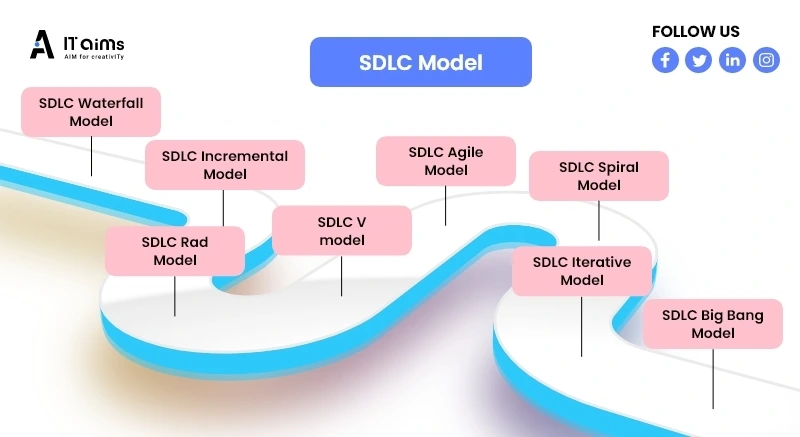
SDLC Waterfall Model
The waterfall model is the most popular and widely accepted SDLC model. In this model, the development process is divided into several phases, and the output of one phase is transferred as an input to the next phase.
SDLC Incremental Model
It is not an individual model but a series of waterfall cycles. Requirements are grouped at the start of the project, and each group will follow the SDLC model to develop software. Each SDLC cycle will add more functionalities to the software until all requirements are satisfied. Every cycle will act as the maintenance phase of SDLC for the earlier release/version of the software. If modification is done in the incremental model, then chances are there where development cycles overlap, so it may happen that before the completion of the previous cycle, the subsequent cycle may begin.
SDLC Rad Model
The RAD(Rapid Application Development) model is adopted from the waterfall model and helps develop software in less time. It is based on prototyping and iterative system development with no specific planning. It focuses on groups to gather system requirements.
- Business Modeling
- Data Modeling
- Process Modeling
- Application Generation
- Testing and Turnover
SDLC V model
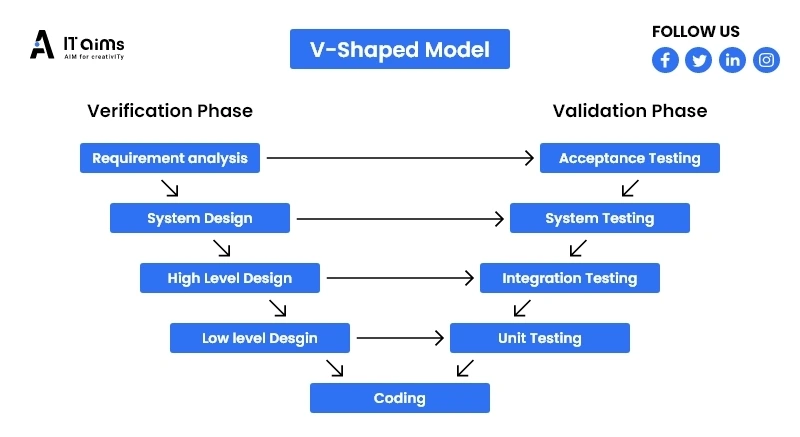
In this model of SDLC, testing and development of the system happen side by side at the same time. In other words, verification of the system happens on one side, and validation happens on another side.
SDLC Agile Model
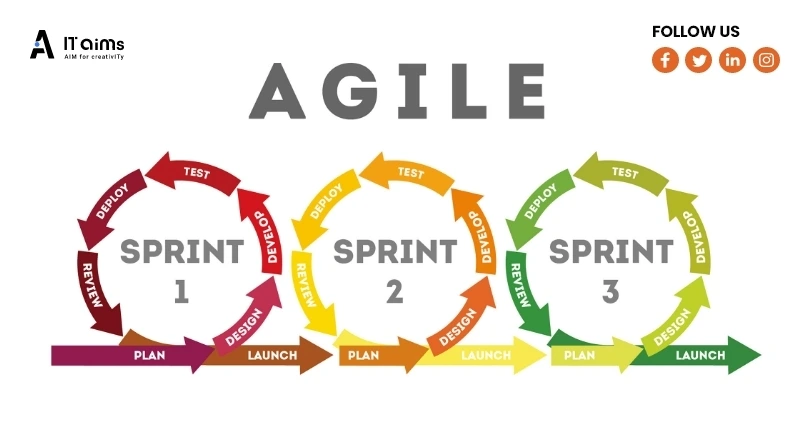
In this model, continuous interaction of development and testing happens during the normal SDLC process in every project. The agile model distributes the entire project into small incremental builds, which are provided in iterations that last upto three weeks.
SDLC Spiral Model
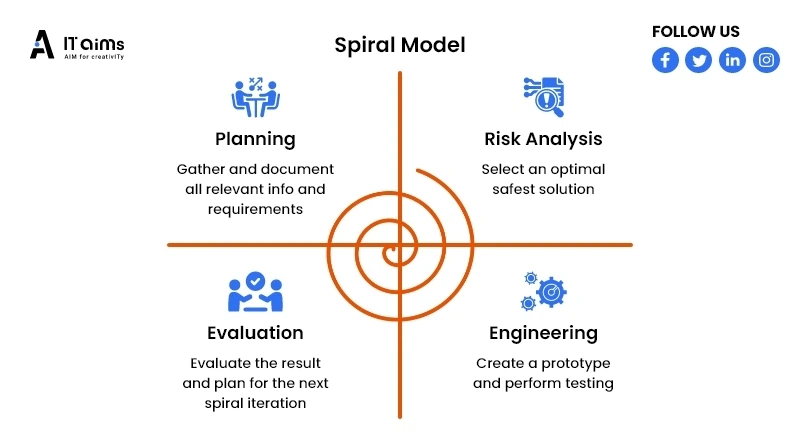
This model involves the development team adopting elements of one or more models like incremental, waterfall, and incremental. So it is considered a risky model to work with.
The best features of the waterfall model and the prototyping model are adopted into this model for the best results. The spiral methodology combines concurrency and rapid prototyping in development activities.
SDLC Iterative Model
In this model of SDLC, the focus is on the initial and simplified implementation, which will gain complexity with progress. A broader feature set will also be added as system development progresses. The iterative model will break down an extensive application into smaller pieces for the development work.
SDLC Big Bang Model
This model involves all resources in system development with less or no planning. Requirements are implemented as and when they arrive.
This model is suitable for small-size software development developed by a small team of developers. This model is useful for academic software development. Projects with unknown requirements or without a release date can be developed with this model.
Secure SDLC
SDLC life cycle phases and models are well known. Now let us discuss something about Secure SDLC.
When a business develops a website or web application, it becomes its intellectual asset. Therefore, proper cybersecurity concerns must be discussed to create a secure SDLC. Now, let us discuss what a secure SDLC is.
In the first phase of the SDLC life cycle, teams must work on identifying necessary policies and criteria to process the system after its deployment.
In the next step, the implementation of threat modeling must be assessed to test software from the possible vulnerable scenarios and environments.
The developers and QA team must assess potential security issues, and until then, an intrusion detection system must be placed to protect the system.
We at ITaims, are the best software development company in Ahmedabad using popular SDLC models. Our developers follow W3C coding standards for software development. We never leave any stone unturned in delivering standard software built on cutting-edge technology.
FAQs
- Q.1: What is the full form of SDLC?
SDLC stands for "Software Development Life Cycle". It describes the various steps used to develop software in a systematic way.
- Q.2: What are the 7 phases of a software development life cycle?
The seven phases of SDLC include Requirement gathering and analysis, Feasibility study, Prototyping and Design, Development, Testing, Deployment and Maintenance
- Q.3: Is SDLC waterfall or agile?
SDLC is more like a waterfall model. The waterfall model is a classical model used in the system development life cycle to create a system with a linear and sequential approach.
- Q.4: What is agile and waterfall?
Waterfall is a linear system of working that requires the team to complete each project phase before moving on to the next one while Agile encourages the team to work simultaneously on different phases of the project.
- Q.5: What are the examples of SDLC?
The most common SDLC examples or SDLC models are listed below.
- Waterfall Model
- Incremental Model
- Rad Model
- V model
- Agile Model
- Spiral Model
- Iterative Model
- Big Bang Model
Popular Searches
Tags:
